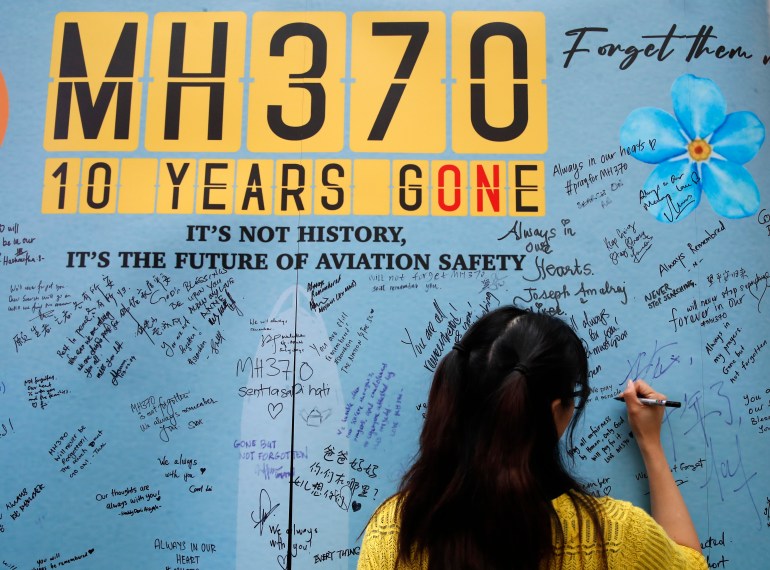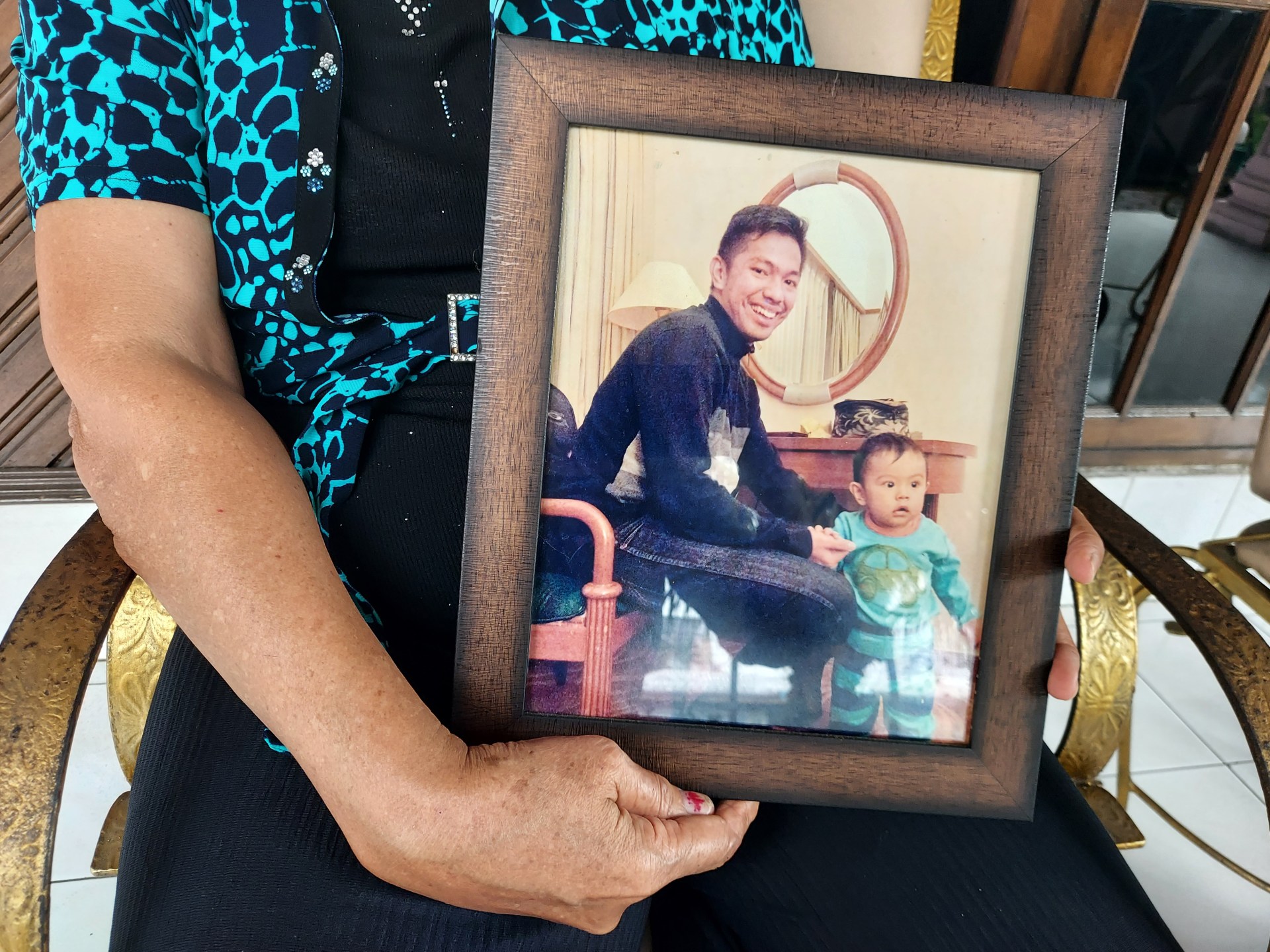Medan, Indonesia – Herlina Panjaitan has not changed her mobile phone number since her son, 25-year-old Firman Chandra Siregar, went missing 10 years ago.
Siregar, an Indonesian, was a passenger on MH370, the Malaysia Airlines plane that disappeared 40 minutes into its flight from Kuala Lumpur to Beijing in the early hours of March 8, 2014 and was never heard from again.
It is important to 69-year-old Panjaitan that her number remains the same, just in case her youngest son tries to call her.
“That was the number I used at the time and that is the number Firman has for me. I still hope he will call and ask me to go and pick him up, wherever he is,” she told Al Jazeera.
Panjaitan had travelled to Kuala Lumpur from her home in Medan, Indonesia with her daughter-in-law and grandson the night before Siregar departed for Beijing, so the family could spend some time together before he started his new job with an oil company in China.
Before he left for the airport to catch the late-night flight, Panjaitan helped her son pack his belongings, including a bag filled with warm clothing for Beijing’s freezing winter.
The family took photographs together, with Siregar beaming as he played with his nephew.
The pictures now hang on the wall of the family’s home in Medan, which lies on the other side of the Strait of Malacca facing Malaysia.
“I told him to be careful and call me when he got to Beijing,” Panjaitan said. “There was no feeling that anything was about to go wrong.”
The next morning, Panjaitan got a call from her daughter who worked at the Indonesian embassy in Mexico to ask her if she had heard the news about MH370.
“She just said that she had heard that it had lost contact with air traffic control,” she recalled. “I didn’t know what to think.”
Panjaitan and her family immediately rushed to Kuala Lumpur International Airport (KLIA) where the families of the 239 passengers and crew on board were briefed on the plane’s mysterious disappearance.
“That is when I started to believe that it had really gone missing,” she said.
Ten years since it took off from KLIA, the plane’s fate has become one of aviation’s greatest mysteries.
No one has been able to say with any certainty what happened to the Boeing 777 after Captain Zaharie Ahmad Shah signed off from Malaysian air traffic control with the words “Good night, Malaysian three seven zero”, and prepared to enter Vietnamese airspace.
According to satellite data, rather than continuing on to Beijing, the plane dramatically veered off course, flying back across northern Malaysia and skirting around Indonesia, before heading south towards the deep waters of the Indian Ocean.
Panjaitan said that she called Siregar’s mobile phone after she heard the news and that it had rung several times but that no one had answered.

Two weeks later, then Malaysian Prime Minister Najib Razak announced the plane had “ended” its journey in the remote southern Indian Ocean.
‘The best child’
Siregar, a graduate of Indonesia’s prestigious Bandung Institute of Technology, was the youngest of five children – three boys and two girls – and Panjaitan says he was “the best”.
“That doesn’t mean my other children aren’t amazing,” she explained. “One works as a prosecutor and another is a diplomat, but Firman was just the best child and my other children understand what I mean when I say that. He was so handsome, so well-behaved, so respectful and so kind.
“He never gave me any trouble as a child, and he knew what to do and what not to do without me telling him.”
Before he went to Beijing, Siregar had introduced his mother and family to his girlfriend and her parents, who had travelled from Bandung to meet Panjaitan and her husband Chrisman.
“They said they wanted to get married and I was happy that he’d found his life partner,” she said.
Six months after the plane went missing, Panjaitan and her husband went to Bandung to meet Siregar’s girlfriend and gave her their blessing to move forward with her life.
“We said that if she wanted to get married in the future, she should do it,” Panjaitan told Al Jazeera. “She didn’t say anything, just cried. And we cried too, it was just so sad.”
Many theories, few answers
Endless speculation has filled the void left by the failure to find MH370.
Some claim Captain Zaharie engineered a sophisticated murder-suicide plot to deliberately crash the plane into the ocean.
Others suggest that the plane was hijacked, deliberately shot down, or suffered a technical malfunction that cut off its communication systems and incapacitated the pilots leading to its eventual crash.
None of the claims has been proven.
Searches have proved fruitless, including a significant underwater and air search across an area of 120,000sq km (46,332sq miles) that cost $147m and was led by an Australian team in conjunction with Malaysia and China.
The Malaysian authorities have also launched several investigations that culminated in a 495-page report that was finally released in 2018. It found that while foul play was likely, it was not possible to say who was responsible.
Last week, ahead of the 10th anniversary, Malaysia’s Prime Minister Anwar Ibrahim reiterated that Malaysia was prepared to reopen an investigation if new evidence emerged.
Malaysia’s transport minister, Anthony Loke, has also said that he has plans to meet US marine robotics company, Ocean Infinity, to discuss a new proposed underwater search.
Panjaitan said that her family welcomes any renewed investigation.
Some fragments from the plane have washed up on East African beaches, including a flaperon that forms part of the wing, but there has been nothing more substantial.
For Panjaitan that leaves room for hope.
“If it crashed, why haven’t they found it? It is a huge plane. What is important is that, alive or not, we still have hope that they will be found,” she said.
“Hopefully Firman is alive, and we can go and pick him up wherever he is. When I see him again, the first thing I will do is give him a big hug.”
Check out our Latest News and Follow us at Facebook
Original Source

